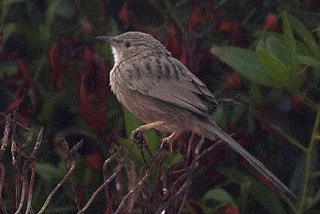
Garrulax is a genus of passerine birds in the laughingthrush family Leiothrichidae.

Leiothrix is a genus of passerine birds in the family Leiothrichidae. They belong to a clade also containing at least the liocichlas, barwings, minlas and sibias. The sibias are possibly their closest living relatives.

The barwings are the genus Actinodura of passerine birds in the family Leiothrichidae. They are found in the hills of Southern Asia, from Eastern India to China and Taiwan.

Laniellus is a genus of passerine birds in the family Leiothrichidae.

The cutias are the passerine bird genus Cutia in the family Leiothrichidae. These birds are found in montane forests of continental South and Southeast Asia. The name is derived from the Nepali name khatya or khutya for the type species, the Himalayan cutia. The cutias are related to the alcippes and the laughingthrushes.

The rufous-backed sibia is a passerine bird in the family Leiothrichidae.

The white-eared sibia is a bird in the laughingthrush family Leiothrichidae. The species is sometimes placed in the monotypic genus Malacias. It was first described by Robert Swinhoe in 1864. There are no subspecies.

The rufous sibia is a rare species of bird in the family Leiothrichidae. It feeds on berries and insects.

The grey sibia is a species of bird in the family Leiothrichidae.

The black-headed sibia is a bird species in the family Leiothrichidae. In former times it was often included with the dark-backed sibia in H. melanoleuca. Together with most other sibias, it is sometimes separated in the genus Malacias.

The long-tailed sibia is a species of Leiothrichidae from Southeast Asia. The species was once placed in the large family Timaliidae, but that family is sometimes split with this species being placed with the laughingthrushes in the family Leiothrichidae. The species is sometimes treated as the only species in the genus Heterophasia, with the other species being placed in the genus Malacias.

The beautiful sibia is a species of bird in the family Leiothrichidae. It is found in China, India, and Myanmar.

The red-tailed minla is a passerine bird in the family Leiothrichidae. It is the only species in the genus Minla.

The capuchin babbler is a species of bird in the family Leiothrichidae.

The scaly chatterer is a species of bird in the family Leiothrichidae. It is also known as the bare-eyed babbler. It is found in Ethiopia, Kenya, Somalia, and Tanzania. Its natural habitat is subtropical or tropical dry shrubland.

The striated babbler is a species of bird in the family Leiothrichidae. It is found in southern Asia from Pakistan to Myanmar.

The rufous chatterer is a species of bird in the family Leiothrichidae. It is found in Ethiopia, Kenya, Somalia, Sudan, Tanzania, and Uganda. Its natural habitats are dry savanna and subtropical or tropical dry shrubland.

The Afghan babbler is a species of bird in the family Leiothrichidae. It is found from southeastern Iraq to south western Pakistan. It was formerly considered a subspecies of the common babbler.

The dark-backed sibia is a bird species in the family Leiothrichidae. In former times it was included the black-headed sibia, H. desgodinsi. Together with most other sibias, it is sometimes separated in the genus Malacias. It is found in China, Myanmar and Thailand. Its natural habitat is subtropical or tropical moist montane forests.

The laughingthrushes are a family, Leiothrichidae, of Old World passerine birds. They are diverse in size and coloration. These are birds of tropical areas, with the greatest variety in Southeast Asia and the Indian subcontinent. The entire family used to be included in the Old World babbler family Timaliidae.



















